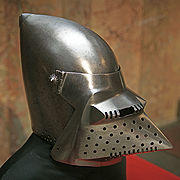
A hounskull helmet, 14th century

Milan hounskull, c. 1400

Cologne hounskull with centrally hinged visor
A hounskull was a form of steel visor attached to bascinet helmets worn in Europe in the Middle Ages, almost invariably by knights and other mounted men-at-arms, from the middle of the 14th century until approximately 1420, bascinets were the most common helmet worn for much of this period. The word hound-skull describes the pointed shape of the visor that was often attached to bascinets, hound-skull shaped visors are occasionally seen on other types of helmets such as armets, bicoque and possibly sallets. It offered extensive protection for the wearer's face at the cost of some visibility, and the visor could be raised and lowered at will by the wearer and most could be removed completely.
Form[]
The hounskull was a form of bascinet with a visor covering the entire face. It is the visor which gives the helmet its name, as this resembles the face of a hound, with a protruding muzzle in order to better protect the face from blows and to grant greater ventilation (which was largely afforded the wearer, when the visor was down, through holes in the "muzzle," such holes being either on the right side of the "muzzle" with additional holes near the mouth,[1] or on both sides).
The visor swung up to uncover the wearer's face when he was not in combat, to grant him better visibility and unrestricted ventilation. This was accomplished in one of two ways. The most common form of visor in Central Europe was held on by a single hinge fastened to the center of the top of the visor, called a Klappviser. The other version had two pivot bolts on either side of the visor attaching it to the bascinet at the temples, and this was the most common form found in Southern, Western and Northwestern Europe.
The wearer peered through two vision slots when the visor was lowered. The vision slots were either relatively flush with the visor, as was the custom in Western Europe, or elevated on mounts on the visor, as was commonly the case in Central Europe.
As with all bascinets, the helmet generally had attachment points for armour to protect the neck and upper body, initially an aventail of mail and, later, plate armour. The chain aventail could have a decorative cloth cover.[2]
Usage[]
The addition of the visor to the bascinet came about due to the ongoing need to protect the face of the man-at-arms. The great helm had been increasingly abandoned for the bascinet in the first half of the fourteenth century, but the bascinet did not protect the face, and this led to increasing casualties to the wearer, particularly in the Hundred Years War, due to the dominance of the longbow as a weapon. Various expedients were adopted, eventually culminating in a full hounskull helmet with its visor soon after 1350.
This helmet became so ubiquitous that it was virtually the symbol of the knight during the second half of the fourteenth century, sometimes illustrated as worn by all knightly combatants in period illustrations. The hounskull lingered in use for some time after that, although it was decidedly out of fashion after the second decade of the fifteenth century. The last time it is depicted in widespread use in period art is by the "Armagnac" mercenaries who invaded Switzerland in 1444.
Modern terminology[]
The English term "hounskull" is considered by some historians to have been a derivation of the German term for the helmet, hundsgugel, meaning "hound's hood."[3] The Victorian historians who described the helmet often referred to it as a "pig-faced" helmet, although that term was not used in the Medieval period.
Notes[]
References[]
- Gravett, Christopher. English Medieval Knight, 1300-1400. Osprey Publishing, 2002. ISBN 1-84176-145-1.
- Nicolle, David. Italian Medieval Armies, 1300-1500. Osprey Publishing, 1983. ISBN 0-85045-477-8.
- Singman, J.; and McLean, W. Daily Life in Chaucer's England. Greenwood Press, 1999. ISBN 0-313-29375-9.
| |||||||||||||||||||||||||||
The original article can be found at Hounskull and the edit history here.
